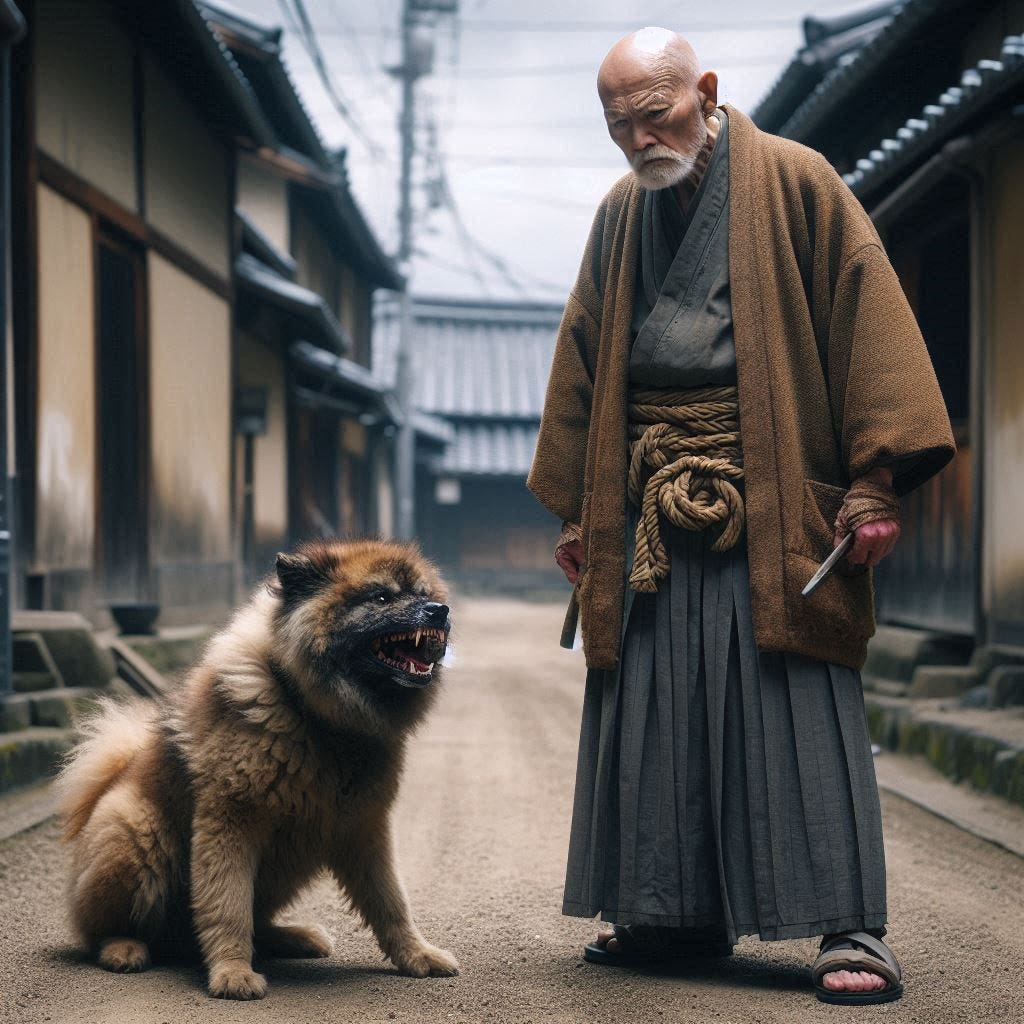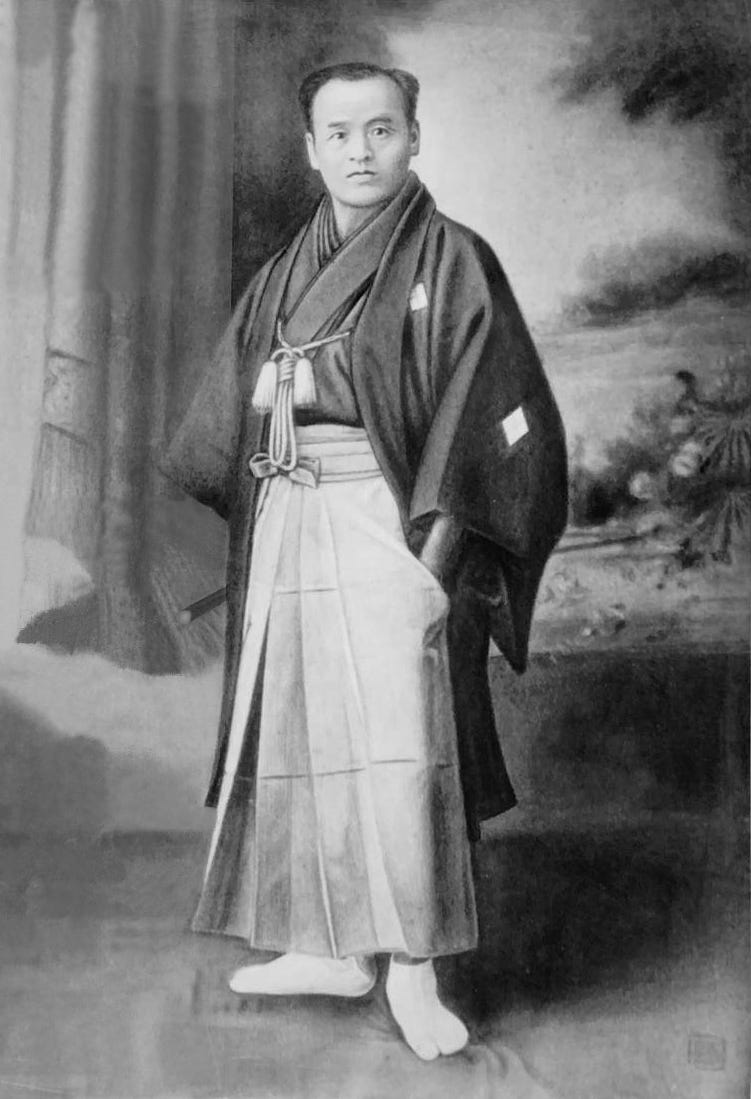An imagined romanticized depiction of events recounted below.
In the previous chapter:
· Early life.
· Duels and challenges.
· Takeda’s physical characteristics.
· The fatal encounter with a gang of construction workers.
In this chapter I explore how he developed his career and connections, and how a legacy was established.
Picture the scene:
One of Ueshiba Morihei’s live-in students, who is looking after the house while his Sensei is away, is suddenly confronted with an irate taxi driver outside of the building, demanding payment for his passenger; a tiny wizened and very angry old man, who won’t pay his fee.
The taxi driver is at his wit’s end, frustrated by his passenger’s eccentricities. He tells the student that he picked up the old man outside of the rail station, after observing him confronting a wild street dog who had the temerity to get in the old man’s way. The oldster was carrying what looked like a walking cane; but really it had a spear point secreted inside it. He suddenly stabbed the dog straight through the heart, killing it instantly – this was Daito Ryu Aikijutsu master Takeda Sokaku.
Account paraphrased from Stanley Pranin’s interview with Mochizuki Minoru; later to become a well-known Budo master in his own right.
But to return to the tale.
Itinerate wandering martial arts teacher.
A life on the road must have suited Takeda Sokaku. He realised he could make money by running a version of pop-up seminars all over Japan.
The younger Takeda Sokaku.
He was able to set up networks of enthusiasts who were keen to pay for the skills learned. He travelled by rail or on foot to various far-flung locations. Although, he did spend such a lot of time in the rugged north of Hokkaido; enough to lay down some roots (of a kind).
(We know much of this because his detailed record books, enrolments and payment receipts still exist; 2000 pages of them).
The impression I get is that for over forty years his working pattern went like this:
Takeda would turn up to some small town, maybe he already knew some of the town officials, perhaps high-up members of the police force, or other martial arts contacts?
Word would spread that he was going to give a demonstration of his skills and teach them to anyone willing to put in the cash.
The ‘demonstration’ would probably happen at an inn and seemed to develop then into a kind of course which typically lasted between seven and ten days; more usually ten days. Each session was around four hours in length. There were claims that Takeda charged huge sums of money, fees for each technique taught, but this is untrue. The reality seems to be that the whole ten-day course was a flat fee of 10 yen; not a lot, even in those days.
As regards teaching strategy; he needed to stamp his authority very early on. He told his son and heir, Takeda Tokimune, that his formula was to identify the strongest guy in the group and start with him. Once people could see how the tiny old man could crush him so easily, everyone else came out as believers.
Why Hokkaido was such an important location in this story.
Takeda himself was from the far west of Japan; Hokkaido is in the furthest north; why was so much of his life focussed there?
He started to visit Hokkaido from about 1904, when it was almost a northern frontier land, with tiny pockets of farming in amongst huge forests, which were teeming with bears. The roads were tricky and infested with robbers, it had a feeling of the colder parts of the American Old West, with lawlessness a part of the package.
A story emerged some time in the early 1900’s, shortly after Takeda Sokaku roamed into the Hokkaido province.
This was a tale about a stretch of road plagued by a group of highwaymen, who the law couldn’t seem to catch up with.
But, unexplainably, one day they were all found dead, killed in the most violent way – one of them had his head twisted completely the wrong way round. The police were relieved but couldn’t find out who had done it; apart from the fact that Takeda had recently passed along that road.
Takeda was compelled to stick around in Hokkaido, partly because, in 1915, one of his most important and talented students had already connected to him, this was Ueshiba Morihei and he was so involved with the irascible old demon that he had a house built for him, so that he would remain in the area. This and other properties was where Takeda would put roots down for a family - he had married a girl thirty years younger than him and on and off they managed to produce seven children. I say ‘on and off’ because he would frequently just hit the road, not telling his family where he was going or when he would return. (He often said, ‘just don’t expect me back’).
What exactly was Takeda teaching?
His son, Tokimune, recounts how his father never factored in any idea of establishing branch Dojo; although various accounts tell us that some of his followers, who were obsessive enthusiasts for his teaching, actually built Dojo on their own property to convince Takeda that it was worth sticking around – note; this was their initiative, not his.
A re-touched formal portrait of Takeda Sokaku.
Tokimune said that very few people in those early days were granted teaching licences; mostly because Takeda Sokaku didn’t hang around for any great length of time to create continuity. It was only dogged students like Ueshiba who basically either followed him around, racking up training hours with him, or even encouraging him to temporarily uproot his young family to join Ueshiba on his religious involvement with cult leader Deguchi Onisaburo (although Takeda had no interest in the cosmic shenanigans of Deguchi and Ueshiba).
[To read the remaining half of this article, become a paid subscriber. If you can read beyond this point, that means you are already part of the premier membership, and I thank you for your sponsorship and support of this rather niche area of journalism].






